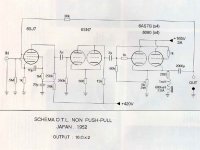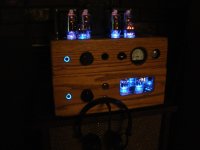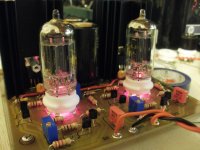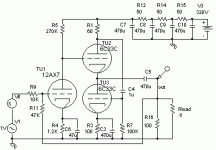Thanks for clicking in!
I am new to the tube amp world, but would like to learn enough to one day build my own. I have to start somewhere however, and I need to drive an experimental set of headphones I am building based on the Neo3 PDRW tweeters over in this thread. To my displeasure I have discovered all of the various amps I can find on the internet aren't "rated" anywhere near down to the 4 ohm impedance of the neo3s. I don't want to introduce distortion or melt the amp. The good news is however, as they are isodynamic planer drivers, the impedance not only never drops below 4 ohms, but is actually entirely flat across the board. Virtually zero dips or peeks whatsoever. From what I do know about amps in general, this makes them easier to drive than a conventional cone, but their extremely-low-for-headphones impedance is making me nervous. Also, they are very sensitive and I need something with a very low noise floor to test them properly. I'm not looking for anything amazing at the moment, just something to tweak them and finish them out. I'd like to not spend hundreds of dollars right now if possible, although I'd certainly be willing to in the future!
I appreciate any advice!
I am new to the tube amp world, but would like to learn enough to one day build my own. I have to start somewhere however, and I need to drive an experimental set of headphones I am building based on the Neo3 PDRW tweeters over in this thread. To my displeasure I have discovered all of the various amps I can find on the internet aren't "rated" anywhere near down to the 4 ohm impedance of the neo3s. I don't want to introduce distortion or melt the amp. The good news is however, as they are isodynamic planer drivers, the impedance not only never drops below 4 ohms, but is actually entirely flat across the board. Virtually zero dips or peeks whatsoever. From what I do know about amps in general, this makes them easier to drive than a conventional cone, but their extremely-low-for-headphones impedance is making me nervous. Also, they are very sensitive and I need something with a very low noise floor to test them properly. I'm not looking for anything amazing at the moment, just something to tweak them and finish them out. I'd like to not spend hundreds of dollars right now if possible, although I'd certainly be willing to in the future!
I appreciate any advice!
amp for 4 ohm headphones
You won't find a "headphone amp" that has 4 ohm capability because by definition a headphone amp is designed to handle the much higher impedance of headphones, anywhere from 40 to 600 ohms.
I suggest that you look at low powered tube amp with a 4 ohm speaker tap and then wire a female stereo phone plug jack to the amp outputs. Jolida and Mini Watt come to mind. (no affiliation)
Just make sure that the amp is common ground on the outputs (most are)as that is what a headphone jack requires.
Good luck with your experiments.
You won't find a "headphone amp" that has 4 ohm capability because by definition a headphone amp is designed to handle the much higher impedance of headphones, anywhere from 40 to 600 ohms.
I suggest that you look at low powered tube amp with a 4 ohm speaker tap and then wire a female stereo phone plug jack to the amp outputs. Jolida and Mini Watt come to mind. (no affiliation)
Just make sure that the amp is common ground on the outputs (most are)as that is what a headphone jack requires.
Good luck with your experiments.
To drive 4 ohms, you'll need a design more like a very low power speaker amp, rather than a headphone amp.
To be honest, if I were you, I'd start off with a small solid-state amp using a power opamp or a chip amp.
Do you know how much voltage you need into 4 ohms?
Another thing you may want to experiment with is varying the damping factor - the output impedance of the amp. This can be as simple as inserting a resistor or even a pot in series with the output. But you'd want to start out with something with a very low Zo, which again suggests a solid-state amp... or a tube amp with a lot of feedback.
Once you understand what the ideal amp is (output, gain, Zo) then it's pretty easy to optimize a tube amp circuit for it.
Pete
To be honest, if I were you, I'd start off with a small solid-state amp using a power opamp or a chip amp.
Do you know how much voltage you need into 4 ohms?
Another thing you may want to experiment with is varying the damping factor - the output impedance of the amp. This can be as simple as inserting a resistor or even a pot in series with the output. But you'd want to start out with something with a very low Zo, which again suggests a solid-state amp... or a tube amp with a lot of feedback.
Once you understand what the ideal amp is (output, gain, Zo) then it's pretty easy to optimize a tube amp circuit for it.
Pete
Pete Millet designed an excellent headphones amp using the ECC99 tube and an output transformer. I improved this idea by altering the topology to include unconditionaly stable negative feedback. I also tesed it with low cost Edcor transformers rather than the very good but very expensive Sowter ones that Pete used. The results were excellent. So my suggestion to you would be to build either Pete's or my headphones amp but change the output transformer to something like and Edcor XSE10-4-8K
EDCOR - XSE10-4-8K
Cheers
Ian
EDCOR - XSE10-4-8K
Cheers
Ian
It looks like I won't be able to find a 4ohm headphone amp at all, so my options are modifying a low power speaker amp or building one myself, tube or otherwise solid-state.
I love the idea of building one myself, I wanted to do that eventually anyway. I'd like to go the route you suggested Ian, I'm interested in your improvement with unconditionally stable negative feedback. Could you point me towards the path of getting started? I'm a quick learner but I've never built an amp before. (Edit: Well, from scratch, anyway.)
Thanks for all of your input guys!
David
I love the idea of building one myself, I wanted to do that eventually anyway. I'd like to go the route you suggested Ian, I'm interested in your improvement with unconditionally stable negative feedback. Could you point me towards the path of getting started? I'm a quick learner but I've never built an amp before. (Edit: Well, from scratch, anyway.)
Thanks for all of your input guys!
David
Here's a link to the orignial thread about the improved tube headphones amp:
http://www.diyaudio.com/forums/tubes-valves/191632-improved-tube-headphones-amp.html
The schematic of one channel is in the first post. If you look at the very last post in the thread by techbiker you will see he is very much a beginner and did successfully build one
And here is a link to Pete Millet's orignal design that inpsired it:
ECC99 SRPP Headphone Amp
Before we go any further we need to check the sensitivity of your headphones. You are using an unusual driver so we cannot assume the sensitivity is going to be anywhere similar to that of regular headphones. From what I can gather they seen in general to be of lower sensitivity than regular headphoes. Do you know what sound level in dB SPL is produced for an input power of 1mW?
Cheers
Ian
http://www.diyaudio.com/forums/tubes-valves/191632-improved-tube-headphones-amp.html
The schematic of one channel is in the first post. If you look at the very last post in the thread by techbiker you will see he is very much a beginner and did successfully build one
And here is a link to Pete Millet's orignal design that inpsired it:
ECC99 SRPP Headphone Amp
Before we go any further we need to check the sensitivity of your headphones. You are using an unusual driver so we cannot assume the sensitivity is going to be anywhere similar to that of regular headphones. From what I can gather they seen in general to be of lower sensitivity than regular headphoes. Do you know what sound level in dB SPL is produced for an input power of 1mW?
Cheers
Ian
Thank you!
As far as sensitivity, you are very correct about them being less sensitive than normal headphones. I wouldn't hesitate to say they are extremely less sensitive. I don't yet have an effective way to measure sensitivity, but I have been considering the purchase of the "Dayton Audio OmniMic V2 Precision Measurement System"
Would this be effective to measure sensitivity @ 1mW? (Edit: I'm not sure how it handles headphone measurement.) Right now the best I know is the manufacturer's specification @ 90.5 dB 2.83V/1m.
David
As far as sensitivity, you are very correct about them being less sensitive than normal headphones. I wouldn't hesitate to say they are extremely less sensitive. I don't yet have an effective way to measure sensitivity, but I have been considering the purchase of the "Dayton Audio OmniMic V2 Precision Measurement System"
Would this be effective to measure sensitivity @ 1mW? (Edit: I'm not sure how it handles headphone measurement.) Right now the best I know is the manufacturer's specification @ 90.5 dB 2.83V/1m.
David
Last edited:
Thank you!
As far as sensitivity, you are very correct about them being less sensitive than normal headphones. I wouldn't hesitate to say they are extremely less sensitive. I don't yet have an effective way to measure sensitivity, but I have been considering the purchase of the "Dayton Audio OmniMic V2 Precision Measurement System"
Would this be effective to measure sensitivity @ 1mW? (Edit: I'm not sure how it handles headphone measurement.) Right now the best I know is the manufacturer's specification @ 90.5 dB 2.83V/1m.
David
OK, 2.83 volts rms into 4 ohms is 2 watts!!! but that is for 90dB SPL at 1 metre. You will probably be operating at about 1cm which would be 40dB louder of 130dB SPL. You clearly don't want it that loud but 20dB less at 110dB SPL would be pretty loud and that would need only 20mW of power. So it looks like the available 200mW from the heaphone amp is going to be enough even allowing for some acoustic losses in the headphone itself.
I have zero experience/expertise in measuring headphones so I cannot advise you on what would be suitable but perhaps it won't be necessary.
Cheers
Ian
Okay good, I like the sound of measuring not being necessary. I have done some reading into measuring the frequency response of headphones. It was originally suggested for the purpose of EQ'ing the neo3s, but it turns out to be quite a bear to tackle. I imagine measuring sensitivity would be much more simple, but where there is math and manufacturer specifications I am satisfied.
By the way, I got them sounding great without EQ through physical alteration.
I'll start educating myself on amplifier design asap!
David
By the way, I got them sounding great without EQ through physical alteration.
I'll start educating myself on amplifier design asap!
David
With a power requirement that low you probably will not need any voltage amplification so could just use a current buffer. Doing this with a mosfet is
real easy. If I just had to have a 1/2 watt tube amp I would think about
modifying this circuite. I would replace the 2 voltage dain stages with just
one triode stage and just use one or 2 output tubes.
real easy. If I just had to have a 1/2 watt tube amp I would think about
modifying this circuite. I would replace the 2 voltage dain stages with just
one triode stage and just use one or 2 output tubes.
Attachments
With a power requirement that low you probably will not need any voltage amplification so could just use a current buffer. Doing this with a mosfet is
real easy. If I just had to have a 1/2 watt tube amp I would think about
modifying this circuite. I would replace the 2 voltage dain stages with just
one triode stage and just use one or 2 output tubes.
Trouble is, for 200mW into 4 ohms you need over 200mA of current. OK you can do that with a MOSFET but then there's little point having any tubes in there.
Cheers
Ian
A hybrid tube input with Mosfet class A follower works great. Several designs available, check out the headphone forum......
I've built several of them and they are wonderful, with great clarity and sound stage.
I'm not a glass purist, I'l mix sand in my glass....
I've used 12au7's at low voltage and triple triodes at 220VB+ with mosfets and other sand components, Black hole quiet till you crank it up.
I've built several of them and they are wonderful, with great clarity and sound stage.
I'm not a glass purist, I'l mix sand in my glass....
I've used 12au7's at low voltage and triple triodes at 220VB+ with mosfets and other sand components, Black hole quiet till you crank it up.
Attachments
Last edited:
Thanks for clicking in!
I am new to the tube amp world, but would like to learn enough to one day build my own. I have to start somewhere however, and I need to drive an experimental set of headphones I am building based on the Neo3 PDRW tweeters over in this thread. To my displeasure I have discovered all of the various amps I can find on the internet aren't "rated" anywhere near down to the 4 ohm impedance of the neo3s. I don't want to introduce distortion or melt the amp. The good news is however, as they are isodynamic planer drivers, the impedance not only never drops below 4 ohms, but is actually entirely flat across the board....
This will actually be a very easy amp to design and build. I assume you don't need more than 1 watt per channel of power. This means you can use a Class A amp and not have to deal with phase splitters.
The single most important and expensive and massive part of a tube amp is the iron core transformers. Select those first. Theaaudio output transformers will have more effect on the soud than any other component. Al you need is a pair of transformers with a 4 ohm output. You can buy them with multiple taps on the secondary. with one with 4, 8 and 16 ohm taps and you can use the amp to drive different loads.
A very conservative choise for a transformer is a 1629SEA by Hammond buy that at $160 and you need two. Edcor has some good ones for a LOT less Just use a 6V6 tube and yu will have 10X more power then you need.
All tube amps need a transformer to match the very high impedance and volts from the tube to to 4 or 8 ohm load.
You might look at Simplest OTL thread that started back on July 8 2005 .
Post 5 has a 3 watt otl using a pair of 6c33c tubes . You could probably
modify it to use a pair of 6080 tubes in stead of the more expensive 6c33c.
But as I said earlier sense you don't need any voltage amplification a
mosfet power follower would be much cheaper and easier to build.
Post 5 has a 3 watt otl using a pair of 6c33c tubes . You could probably
modify it to use a pair of 6080 tubes in stead of the more expensive 6c33c.
But as I said earlier sense you don't need any voltage amplification a
mosfet power follower would be much cheaper and easier to build.
Attachments
You might look at Simplest OTL thread that started back on July 8 2005 ....
What is the output impedance of that amp? Is it 4 ohms?
Also I don't like the idea of OTL for headphone amps. The only isolation from the high voltage power supply is one capacitor.
But maybe more importantly an output cap pretty much has to be an electrolytic (470 uF in this case) and you don't want those in the signal path. The sound is not the best.
You pretty much need a transformer (or solid state parts) to get to 4 ohms
I'm still taking in all these very educational replies and don't want to hinder their development, but I would like to insert a question.
Would it be worthwhile to consider balanced topology? I have a great balanced source. I understand it may potentially make the amp twice as expensive, but I don't want to rule it out based on that alone.
Would it be worthwhile to consider balanced topology? I have a great balanced source. I understand it may potentially make the amp twice as expensive, but I don't want to rule it out based on that alone.
I'm still taking in all these very educational replies and don't want to hinder their development, but I would like to insert a question.
Would it be worthwhile to consider balanced topology? I have a great balanced source. I understand it may potentially make the amp twice as expensive, but I don't want to rule it out based on that alone.
With a tube design, for a balanced amp topology you need a transformer at the input and one at the output. For a balanced source but an unbalanced amp topology you need a transformer at the input and one at the output. The galvanic isolation and pretty much all the CMMR takes place in the input transformer, so unless you are expecting huge amounts of interference to hit the amp itself I would say a balanced amp topology has little to offer.
Cheers
ian
Would it be worthwhile to consider balanced topology? I have a great balanced source. I understand it may potentially make the amp twice as expensive, but I don't want to rule it out based on that alone.
That was how the old Hammon Organ "tone cabinets" worked. and YES the number of componets seems to be double, but you also double the gain and the power. There is a rather large payback in that you don't need a phase splitter in the power amplifier. That saves a tube but also the distortion of that stage.
In their system the organ console produced three channels of balanced output signals from the tone wheels and spring reverb and this was cabled out to any number (from 1 to 6 or 8) cabinets. Each cabnet had three balanced amplifiers, a power supply and speakers in a wood box the size of a home washing machine. The only drawback was the cost. A large installation could cost literally as much as 10 new cars. But that was "cheap" compared to a "real" pipe organ.
The Hammond system was truly balanced in that there was no input transformer. The two sides ran 180 degrees anti-phase all the way to the output transformer. There were two negative feedback loops.
So you'd not be the first. Other very high end professional audio systems were build this way but home HiFi never used balanced signals because of the double cost.
Today to cut costs, many systems that accept balanced inputs convert the balanced input to single ended by using an input transformers but those are NOT "balanced amplifiers" They are single ended amps. You would, no doubt, get lower noise with a true balanced amp and if you cary that balance all the way through the power section you avoid the phase splitter. One big design problem is making sure the gain is the same on both sides. NFB takes care if that but it must be the same on both sides.
It would be a fun experiment but not a good first project. I'd go with a simple class-a single ended amp as a first project. Build a 5W amp with a 6V6 tube first. Given the right speaks it can be "way loud." Yes it can. I have a speaker rated at 105 dB/W at 1M. So it can break 100 dB with the volume control way down at "2".
Last edited:
Trouble is, for 200mW into 4 ohms you need over 200mA of current. OK you can do that with a MOSFET but then there's little point having any tubes in there.
Cheers
Ian
At 4 ohms he is going to be using an output transformer. (or as you say solid state.) A tube based OTL is just a "circus stunt". Seriously I don't know what else I'd call a pair of EL34 (or like) tubes driving headphones. Use transformers and then a 12AU7 tube makes a good power tube
Also with headphone you kind of want to have isolation for the B+ voltage. Yes yu can do that with a huge electrolytic cap but they will one day fail, maybe even shorted and then you have 200 volts across your headphones.
Last edited:
- Status
- This old topic is closed. If you want to reopen this topic, contact a moderator using the "Report Post" button.
- Home
- Amplifiers
- Tubes / Valves
- Tube amp to drive 4 ohm headphones?



